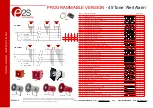
RP0200-2000
2
NACE International
3.2.5 The casing vent hole should be at least one-
half the diameter of the vent pipe (2.5-cm [1.0-in.]
minimum). The casing vent pipe should be a
minimum of 5 cm (2 in.) in diameter.
3.2.6 The casing and carrier pipe shall be properly
supported for the entire length of the pipe, especially
near the ends, to prevent sagging, metallic contact,
and to avoid carrier pipe stress. Refer to Paragraphs
4.3 and 4.4.
3.2.7 Properly designed casing end seals shall be
installed to prevent ingress of water and debris.
3.2.8 Vent pipes shall be designed, using standard
industry methods, to exclude intrusion of water and
debris.
3.3 Metallic Isolation
3.3.1 Sufficient electrically nonconductive spacing
material shall be specified and installed to prevent
metallic contact between the carrier pipe and the
casing, provide adequate support, and minimize
coating damage. Refer to Paragraph 4.4.
3.3.2 Electrical testing facilities shall be installed to
permit verification of metallic isolation. Refer to
Paragraph 4.5.
3.3.3 Metallic short between the casing vent pipe,
test leads, and the carrier pipe shall be prevented.
Refer to Paragraphs 4.3, 4.4, and 4.5.
3.4 Other Design Considerations
3.4.1 Cathodic protection may be considered in
some situations, and applied to the casing as
required by conditions and/or regulations. See
NACE Standard RP0169 for details.
3.4.2 Consideration may be given to placing
inhibited dielectric filler in the annular space. Refer
to Appendix A.
3.4.3 Sound engineering practices shall be used in
the selection of casing materials.
_______________________________________________________________________
Section 4: Installation
This section pertains to the installation of new cased
pipeline crossings, casing extensions, and new casing
installation on existing lines by the split-sleeve method.
Installation of a casing at a highway, railway, or other
crossing may be required by the permitting agency or
owner company.
4.2 The carrier pipe and casing shall be handled and
stored in a manner that minimizes coating and end
damage. Lifting shall be accomplished utilizing approved
slings, wide belts, or appropriate end hooks. If skids are
utilized to support the pipe or casing, padding material
shall be used to prevent coating damage. In addition, the
skids shall be removed upon completion of the
installation.
4.3 New Casing Installation
4.3.1 Cased crossings are installed using various
techniques including boring, directional drilling,
tunneling, and open cutting. If boring or tunneling
methods are used, filling of the annular space
between the casing and excavation is sometimes
required by the permitting agency. Safety is a major
factor during all casing installation work, and all
applicable government requirements must be
followed. If rock or other unexpected obstructions
are encountered during boring operations, the use of
specialized cutting heads or tunneling with oversized
casing and blasting is sometimes necessary.
4.3.2 While fabricating casings, proper butt-weld
alignment must be maintained to prevent casing,
isolator, or spacer damage during push/pull
operations. In addition, slag, bows, etc., must be
removed to prevent damage to the carrier pipe,
coating, isolator, or spacer. Casing diameter is
usually determined by the need to apply concrete
coating, epoxy-polymer concrete coating, or isolators
to the carrier pipe. Welding of casings should be
performed in accordance with the appropriate
welding specification. Radiographic inspection of
casing welds is normally not required.
4.3.3 If possible, the casing vent pipe should be
installed before the carrier pipe to avoid the
possibility of coating damage. If the carrier pipe is
already in place when the vent hole is cut, extreme
care shall be exercised while cutting the vent hole.
The use of nonflammable insulating material to
protect the pipe coating is often required by the
owner company. When two vent pipes are used, the
one at the lower elevation should be installed on the
bottom of the casing to facilitate possible filling of the
casing at a later date. If the vent pipe is “doglegged,”
adequate separation and nonmetallic support
between the vent pipe and carrier pipe is required.
Содержание CP 1
Страница 1: ...CP 1 Cathodic Protection Tester Course Manual February 2005 NACE International 2000 ...
Страница 265: ......
Страница 266: ......
Страница 267: ......
Страница 268: ......
Страница 301: ...RP0169 2002 32 NACE International ISBN 1 57590 035 1 ...
Страница 535: ...TM0101 2001 24 NACE International ISBN 1 57590 137 4 ...
















































